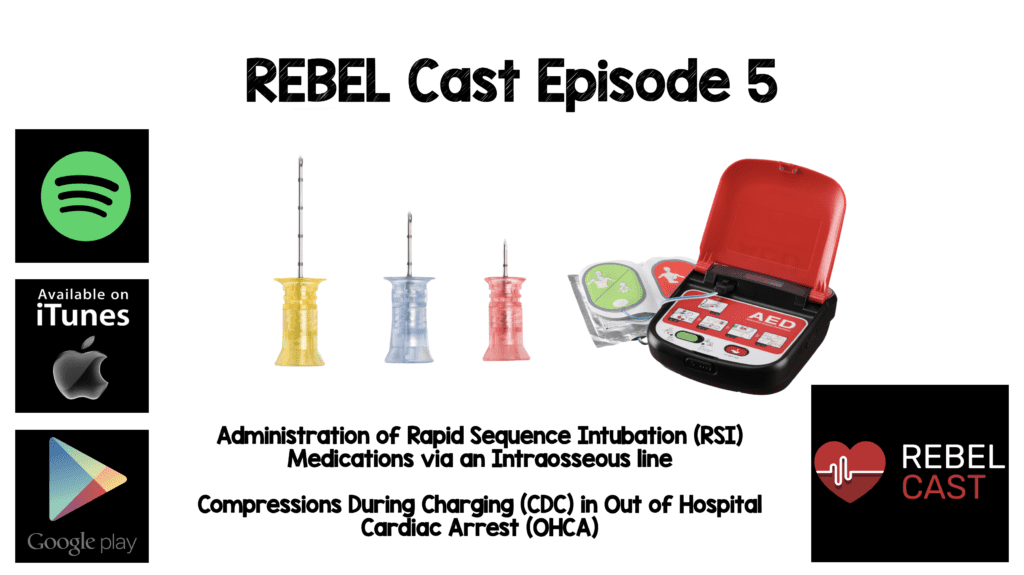
 Welcome to the February 2015 REBELCast, where Swami, Matt, and I are going to tackle two critical care topics that come up frequently in clinical practice in both the pre-hospital setting as well as the emergency department. Today we are going to specifically tackle:
Welcome to the February 2015 REBELCast, where Swami, Matt, and I are going to tackle two critical care topics that come up frequently in clinical practice in both the pre-hospital setting as well as the emergency department. Today we are going to specifically tackle:
Topic #1: Administration of Rapid Sequence Intubation (RSI) Medications via an Intraosseous line.
Topic #2: Compressions During Charging (CDC) in Out of Hospital Cardiac Arrest (OHCA)
REBEL Cast Episode 5: RSI Meds via IO & CPR During Charging in OHCA
Click here for Direct Download of Podcast
Topic #1: Administration of rapid sequence intubation (RSI) medications via an intraosseous line.
Clinical Question: Is the administration of RSI medications via intraosseous (IO) access effective in providing optimal intubating conditions?
Article: Barnard EBG et al. Rapid sequence induction of anaesthesia via the intraosseous route: a prospective observational study. Emerg Med J 2014. PMID: 24963149
Background: Intravenous (IV) delivery of medications has long been the gold standard in medical care. In recent years, however, intraosseous (IO) line placement and use has become more widespread. IO lines address the problem of difficult peripheral IV placement in patients with hypovolemic shock, as the medullary cavity of bones doesn’t collapse. Despite wider use, there are few studies looking at medication delivery via IO access.
Details:
- Prospective, observational study of 34 trauma patients at a combat hospital in Afghanistan.
- 29/35 patients arrived via physician led Medical Emergency Response Team (MERT).
- Primary outcome measure (1stpass intubation success) achieved in 33/34 patients – 97% (95% CI 91 – 100%).
- Secondary outcome measure (Cormack-Lehane grade 1 view with direct laryngoscopy) seen in 91% of patients (95% CI 81-100%).
Strengths
- This is the first study looking at the efficacy of RSI meds administered through an IO line.
- The first pass success rate in this study was comparable to historical data using IV access.
Weaknesses
- There was no comparison group in this study prohibiting the comparative evaluation of IO and IV lines.
- All patients in the study were trauma patients, military personal and the median age was 24 years.
- First pass success may have been affected by the experience level of the physicians included in this study.
Clinical Bottom Line: IO administration of RSI medications was effective in achieving good intubating conditions and 1st pass success rate was comparable to that seen with IV medication administration.
Topic #2: Compression During Charging (CDC) in Out of Hospital Cardiac Arrest (OHCA).
Clinical Question: Does compression during defibrillator charging shorten shock pause duration and/or improve clinical outcomes during shockable out of hospital cardiac arrest?
Article: Cheskes S et al. Compressions During Defibrillator Charging shortens Shock Pause duration and Improves Chest Compression Fraction During Shockable Out of Hospital Cardiac Arrest. Resuscitation 2014; 85 (8): 1007 – 11. PMID: 24830868
Background: It is well known that pauses in cardiopulmonary resuscitation (CPR) are associated with decreased survival in out of hospital cardiac arrest. A lot of focus has been placed on improving CPR quality, specifically: chest compression fraction (CCF)*, compression rate/depth, and peri-shock pause duration. Chest compressions performed during the defibrillator charging phase is one technique that has been suggested in an attempt to decrease pre-shock pause duration. If CDC consistently shortens pre-shock pause duration, it may have significant impact on both termination of ventricular fibrillation/tachycardia and survival from OHCA.
*Chest Compression Fraction (CCF): The percent of time CPR is done during cardiac arrest
Details:
- Retrospective review of 129 Out of Hospital Cardiac Arrest (OHCA) cases with shockable rhythms in Ontario, Canada
- Primary Outcome: CDC and shock pause duration
- Secondary Outcome: Association between CDC and CPR Quality Measures (i.e. chest compression fraction)
- Median pre-shock pause decrease from 15.0 sec without CDC to 3.5 sec with CDC
- Median peri-shock pause decrease from 21.0 sec without CDC to 9.0 sec with CDC
- CPR fraction increased from 71% without CDC to 77% with CDC
- No statistical differences in post-shock pause time, compression depth or compression rate
- The study was not powered well enough to determine clinical outcomes such as Return of Spontaneous Circulation (ROSC) and survival to hospital discharge
Strengths:
- First study to evaluate the impact of compression during charging on out of hospital cardiac arrest
Weaknesses
- After classroom and manikin training of EMS, only 56% performed CDC initially
- Study sample size was impacted by low rate of VF/VT in this study population (i.e. 20%)
- This was abstracted data from an observational registry which can only show association and not causal relationships
- The study took place in an area of heavily monitored EMS systems which allowed for rapid response times (may not be able to generalize this to areas with more sparse EMS systems)
Clinical Bottom Line: Compression during defibrillator charging does decrease shock pause duration and improve chest compression fraction in shockable OHCA, but a larger sample size is required to determine the impact of this on clinical outcomes
For more on the above topics checkout:
- Salim Rezaie on ALiEM: Intraosseous Rapid Sequence Intubation
- Rick Abbott from Life in the Fast Lane: Clear!!!
- Salim Rezaie on REBEL EM: CPR: Hands-on or Hands-off Defibrillation
- Ken Milne at The Skeptics Guide to Emergency Medicine: SGEM #107 – You Can’t Touch This – Hands On Defibrillation
- A MUST LISTEN: Scott Weingart Interviews Cliff Reid –> Podcast 82 – Mind of the Resuscitationist
The post REBEL Cast Episode 5: RSI Meds via IO & CPR During Charging in OHCA appeared first on REBEL EM - Emergency Medicine Blog.
